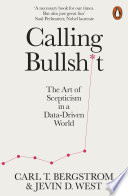

The book begins by defining what constitutes 'bullshit' in the context of information dissemination. The authors emphasize that bullshit is not merely a lie; it is a form of communication that disregards the truth for the sake of persuasion or manipulation. They explore how language can be manipulated to create misleading narratives, and they provide tools to discern when information is being presented in a deceptive manner. This understanding is crucial in a world saturated with data and opinions, where distinguishing fact from fiction has become increasingly challenging.
Continue readingData is often used to lend credibility to claims that may otherwise be questionable. The authors delve into the misuse of statistics and data representation, illustrating how graphs and charts can be manipulated to mislead audiences. They introduce concepts like 'data visualization' and the importance of scrutinizing the sources and methods behind data collection. This idea underscores the necessity of being data-literate, encouraging readers to not take data at face value and to question the integrity of the information presented to them.
Continue readingA central theme of the book is the promotion of critical thinking skills. The authors advocate for a skeptical approach to information, urging readers to ask probing questions about the claims they encounter. They provide frameworks and mental models for evaluating the validity of arguments and evidence. By fostering a mindset of inquiry and skepticism, individuals can better navigate the complex landscape of information and avoid falling prey to bullshit. This idea is particularly relevant in the age of social media, where misinformation can spread rapidly.
Continue readingThe authors discuss the broader implications of bullshit on societal discourse and decision-making. They argue that the prevalence of misleading information can erode trust in institutions and hinder informed decision-making among the public. This idea highlights the responsibility of individuals to not only be discerning consumers of information but also to contribute positively to the discourse by promoting clarity and truthfulness in their own communications. The societal impact of bullshit is a call to action for readers to engage thoughtfully with the information they encounter.
Continue readingIn response to the challenges posed by bullshit, the authors emphasize the importance of education and media literacy. They argue that educational systems must equip individuals with the skills necessary to critically assess information and recognize bullshit. This includes teaching students about logical fallacies, the scientific method, and the importance of evidence-based reasoning. By fostering media literacy, society can empower individuals to become informed citizens who can engage thoughtfully with complex issues.
Continue readingThe book offers practical strategies for individuals to combat bullshit in their everyday lives. These strategies include fact-checking claims, seeking out credible sources, and engaging in discussions with an open mind. The authors encourage readers to cultivate a habit of questioning and verifying information before accepting it as truth. This proactive approach is essential for navigating an information landscape rife with deception and manipulation.
Continue readingFinally, the authors address the ethical responsibility of those who communicate information, whether they are journalists, academics, or everyday individuals. They argue that with the power of communication comes the responsibility to convey information truthfully and transparently. This idea serves as a reminder that individuals have the agency to influence the quality of discourse and that ethical communication practices can contribute to a more informed and engaged society.
Continue reading